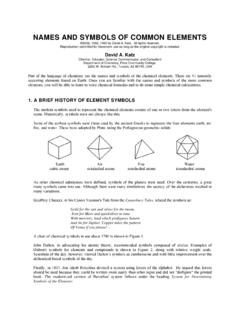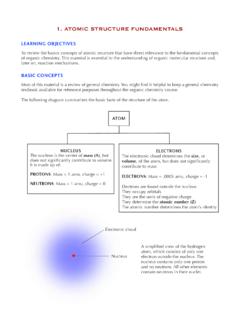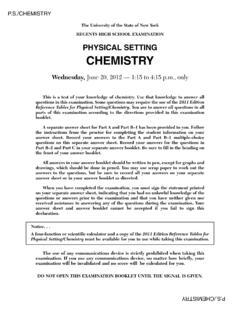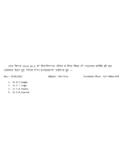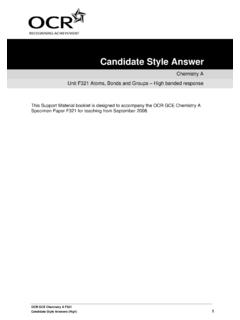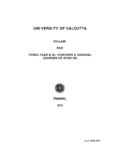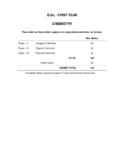Transcription of X-RAY FLUORESCENCE (XRF) - Niton UK
1 Certificate No. LRQ 4000700 Niton UK LimitedUnit 17-19 The Calvert CentreWoodmancott, Winchester SO21 3 BNTel: 01256 397 860 Fax: 01256 397 861 Web: by James Anthony GreenwoodCopyright Niton UKCreated on: 28/09/16 Last Modified: 8 November 2016 11:23 AMPage: 1 of 7 Last Modified: 8 November 2016 11:23 AMPage: 1 of 7 GLOSSARY A GUIDE TO COMMON TERMS X-RAY FLUORESCENCE (XRF):Created by James Anthony GreenwoodCopyright Niton UKCreated on: 28/09/16 Last Modified: 8 November 2016 11:23 AMPage: 2 of 7 Page: 2 of 7 Niton UK - Glossary of XRF TermsAlloy A partial or complete solid solution of two or more elements in a metallic matrix, , steel (Fe + C), brass (Cu + Zn), bronze (Cu + Sn).
2 Alloy Grade The name or designation of an alloy with a particular composition, , C377, Forging brass (Cu , Fe , Pb , Zn ).Assay Qualitative or quantitative analysis of a metal or ore to determine its number Also sometimes called the proton number because it is equal to the number of protons in the nucleus of an atom , Mg = 12, Fe = 26 and Pb = technology Thermo Scientific Au/gold Detection & Identification Technology (AuDIT) is a proprietary plating detection technology developed for, and only available on, Thermo Scientific portable XRF analysers, including the Thermo Scientific Niton XL2 precious metal analyser. Several independent, complementary methods in the software work in tandem to alert users to the probability that an item is plated.
3 The primary, patent-pending technology based on elemental XRF signatures works regardless of the gold concentration of the plated surface layer. This technology works for vermeil (gold-plated silver), as well as gold-plated copper, steel, tungsten and any other non-gold When x-rays interact with low density materials ( , polyethylene) they can be scattered back toward the instrument and the flame retardant (BFR) Bromine is commonly introduced into a product as a brominated flame retardant, which became a concern in the early 1990s when the connection was drawn between BFRs and the halogenated dioxins and furans. Some forms of BFRs, namely polybrominated biphenyls (PBBs) and polybrominated diphenyl ethers (PBDEs), have already been banned under RoHS camera Colour charge-coupled device (CCD) camera and sampling imaging System (integrated as standard into Niton FXL and Niton XL3t GOLDD; optional, Niton XL3t) helps visually identify, locate, specify, and save the image of the analysis area together with elemental analysis reference material (CRM) A standard material that has been certified for certain elements with a given range of uncertainty.
4 Typically, analysis has been performed by multiple methods and multiple A thin covering over a substrate, usually to improve the surface properties such as corrosion resistance. Examples of coatings include anodized surfaces, electrochemical plating, chromate and phosphate coatings, as well as paint and Normalization An XRF technique that provides the best results for a wide range of environmental testing and some mining applications, particularly when it is necessary to measure sub-percent concentrations of heavy elements in samples composed mainly of light elements. In environmental testing projects, it is often highly desirable to be able to quickly measure low concentration levels of all of the eight Resource Conservation and Recovery Act (RCRA) heavy metals (Ag, As, Ba, Cd, Cr, Hg, Pb, Se) on site and in real time.
5 Using Compton Normalisation, Thermo Scientific Niton XRF analysers can measure concentrations of many heavy by James Anthony GreenwoodCopyright Niton UKCreated on: 28/09/16 Last Modified: 8 November 2016 11:23 AMPage: 3 of 7 Page: 3 of 7 Niton UK - Glossary of XRF TermsDigital signal processor (DSP) a device that shapes and produces the spectrum in the XRF core A cylinder of material taken as a sample A pure chemical substance composed of only one type of atom, , iron (Fe), copper (Cu), gold (Au).EPA Method 6200 At its most basic, EPA Method 6200 is a field-screening method for analysis of in situ and ex-situ soil test samples. Our Niton XL3t Series XRF analyser meets the specifications for this industry-standard situ Latin phrase meaning off-site.
6 Often a soil sample is removed from its original location, prepared (dried, ground, sieved, and cupped), and then analysed Providing dual, remote trigger activation for ease of use in multiple orientations, the proprietary telescoping extension pole features an instrument cradle that clamps to the Thermo Scientific Niton analyser, an adapter to hold a GPS or PDA, as well as a fixed tripod 1. A mechanism built into the instrument that allows modification of the X-RAY energy to preferentially enhance the analysis of certain elements in certain matrices 2. A thin support mechanism for sample collection, such as a 37mm air accelerated control (FAC) A well-known source of problems in nuclear and fossil-fuel power plants.
7 FAC occurs when carbon steel piping and components are degraded in the presence of flowing water or steam water with low-dissolved oxygen. As the water flows against the carbon steel material, the stable surface oxide layer (typically Fe3O4) is dissolved into the flowing stream thinning the walls of piping over time and resulting in catastrophic failures due to Parameters (FP) For measuring samples of unknown chemical composition in which concentrations of light and heavy elements may vary from ppm to high percent levels, Fundamental Parameters (FP) analysis is used to simultaneously compensate for a wide variety of geometric effects (including small and odd-shaped samples), plus X-RAY absorption, and secondary and tertiary FLUORESCENCE effects.
8 FP is the preferred analysis tool for mining, precious metals and all metal alloy testing applications. Using this powerful in-factory calibrated instrument, a Thermo Scientific Niton analyser can then measure the full range of element concentrations in a wide variety of samples for years without any additional calibrations or user input of any kind. Geometrically Optimized Large Area Drift Detector (GOLDD ) Thermo Scientific GOLDD technology delivers improvements in light element detection (Mg, Al, Si, P, and S), overall sensitivity and measurement times up to 10 times faster than conventional Si-PIN detectors, and up to 3 times more precise than conventional smaller, silicon drift detectors without helium or vacuum control The measurement and adjustment of materials to keep the elements of interest within a specific concentration by James Anthony GreenwoodCopyright Niton UKCreated on: 28/09/16 Last Modified: 8 November 2016 11:23 AMPage: 4 of 7 Page.
9 4 of 7 Niton UK - Glossary of XRF TermsHalogen The generic name for a group of non-metal elements from Group 17 (formerly VII, VIIA) of the periodic table, comprising F, Cl, Br, I, and At. Halogen free According to IEC 61249-2-21, the accepted definition of halogen free is 900 ppm maximum Cl, 900 ppm maximum Br, or 1,500 ppm maximum total purge 1. The process of replacing the air present surrounding the X-RAY tube and detector with helium gas to permit the direct analysis of magnesium, aluminium, silicon, phosphorus and low levels of sulphur in a variety of sample types. 2. The method preferred over vacuum purge systems for analysis of magnesium, aluminium, silicon, phosphorus and sulphur resulting from its higher reliability and reduced potential for instrument contamination.
10 3. The technique employed by handheld Thermo Scientific Niton XL3t GOLDD analysers and the Niton FXL field X-RAY lab for enhanced light element analysis in metal alloys, mining, soil samples and consumer goods filter The filter used in the instrument to preferentially fluoresce many of the heavy elements [Z = Ag (47)-Ba (56)].Inductively coupled plasma (ICP) Traditional testing method, which is generally accepted as accurate, but also destructive and time consuming. Ultimately, this makes the method inefficient. Infilling taking readings at a higher rate to more closely define the elemental composition of an area of interest; an exploration situ Latin phrase meaning in place; the XRF instrument may be used directly on a sample without moving or preparing it, , taking a soil reading detection limit (IDL) The best possible limit of detection, calculated from a clean sample, , one with no elements Elements below atomic #17.
